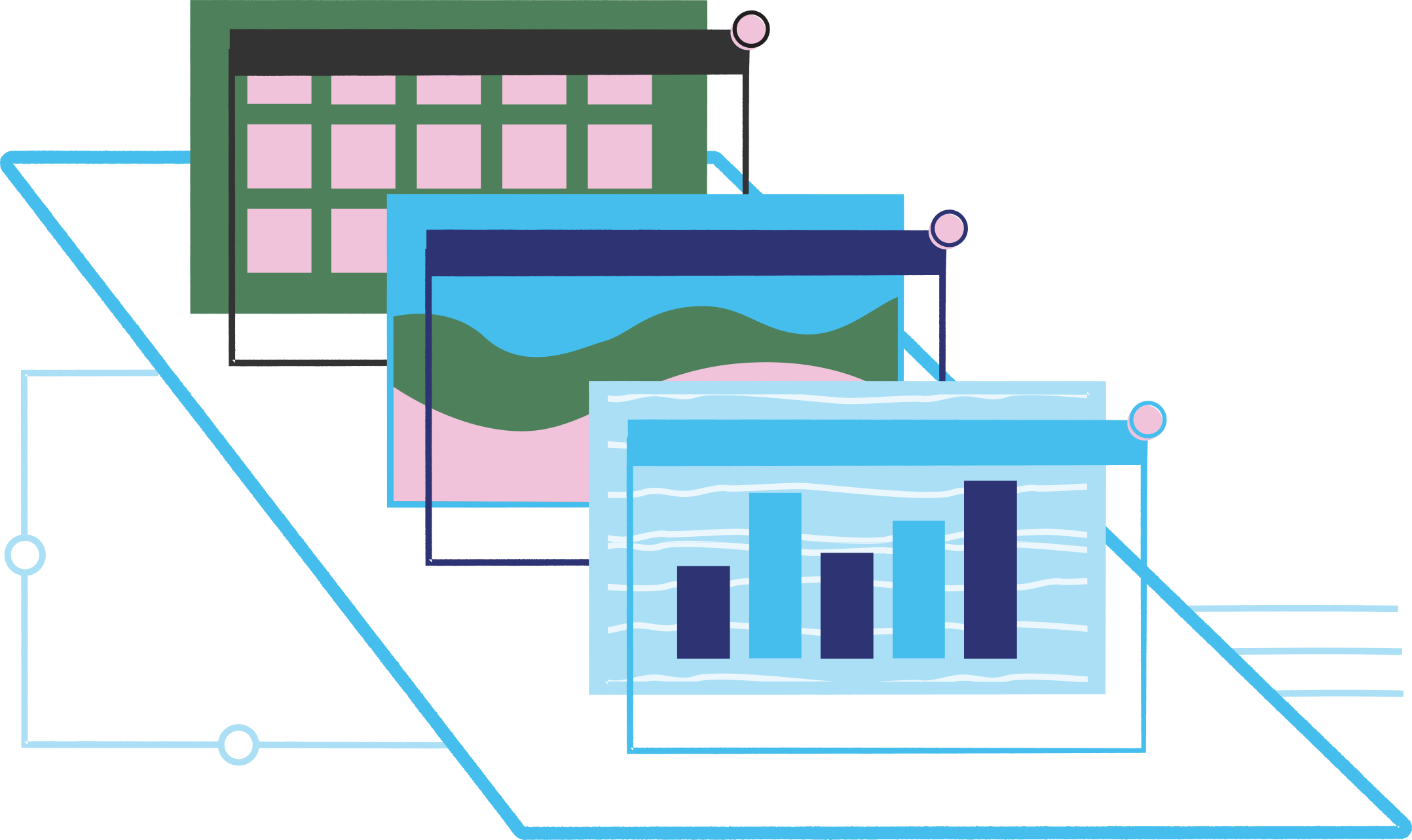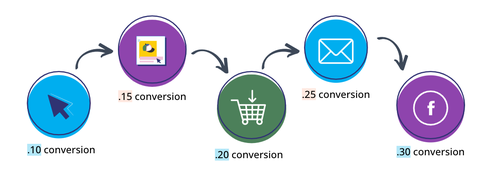Attribution Modeling: What It Is & How to Use It
A Roller once said, “If you’re running more than one marketing channel, you have an attribution problem.”

At first glance, attribution (aka the practice of assigning credit for conversions or revenue to marketing touchpoints) seems pretty straight forward. You run campaigns in various channels and they report their conversion totals back to you, right?
Looking at your individual channel reporting is an important first step, but don’t forget that your customers are very rarely targeted by just one of your marketing campaigns. You run more than one channel for a reason, they each play a critical role in your customer journey. This means that you need to decide which touchpoints get credit and how to organize your data in order to understand what’s working.
Don’t worry, it’s not as scary as it sounds. There are multiple “off-the-shelf” attribution models you can use to organize your data and more accurately assign credit to your individual channels and campaigns. In this article, we will walk you through a few of the commonly used attribution models, discuss how you can apply them to your business, and review how to use them to test and adapt.
What is Attribution Modeling?
Attribution modeling is the process that businesses use to distribute credit for conversions across multiple touchpoints. This exercise enables marketers to define their most successful channels and to optimize their omnichannel strategies. Recently, more multi-channel attribution tools, like funnel tracking, have become available, making attribution modeling simpler than ever. As a result, it has become an essential element of conversion-based marketing strategies.
Why is Attribution Modeling Important?
Attribution is about more than just having a holistic approach to performance evaluation, it’s the tool that turns performance data into actionable insights that scale your business. Finding the best attribution model to apply to your conversion data is a key step in understanding what efforts are truly working versus what can be improved.
Attribution in Action
Good news - Jane is in the market for your product! She takes the following journey before making her purchase.

Jane is in the market for your product! She takes the following journey before making her purchase:
Take a minute to read through each of the touchpoints in Jane’s journey. Ready to see which touchpoint receives credit under different attribution models? Let’s take a look!
Last Click Attribution
Last Click is often a marketer’s first introduction to attribution modeling. The Last Click model, as its name suggests, awards 100% of conversion credit to the last touchpoint that the user clicked on.
Understanding Last Click Attribution
Let’s zoom out for a moment and take a look at what the Last Click model tells us about what’s working within our marketing mix. Because Last Click relies on a customer action, it’s often a model marketers initially feel more comfortable with, but does it provide you with insight that will help your business grow?
Jane’s click through email was an important step in her path to conversion, but it wasn’t the only important step. Her click wasn’t more important than the search campaign that first introduced her to your brand, the retargeting campaign that kept your product top-of-mind, or the Facebook campaign that gave her the promo code.
Jane may not have entered your email campaign without the previous steps, and the Last Click model wouldn’t have even picked up on her journey if she had viewed the email rather than clicked through it.
Remember, the purpose of attribution is to gain insight into your customer journey so that you can scale what’s working and grow your bottom line. Restricting our visibility to a single touchpoint is a good way to block our path to actionable insights and could quickly lead to a lopsided marketing stack and bottlenecked upper funnel. Each of your channels played a vital role, why limit our understanding to only one?
Ready to meet our next model?
Last Touch Attribution
If we look just a little bit past Last Click, we’ll see the Last Touch model. As you may have already guessed, Last Touch also gives 100% of credit to the last touchpoint regardless of whether it was a view or a click.
Understanding Last Touch Attribution
We run into many of the same challenges with Last Touch as we did with Last Click. Jane’s decision to convert didn’t take place within the span of a single touchpoint, it was nurtured over a series of targeted messages. Why would we limit our view to the very last interaction that took place? Although Last Touch starts to paint a larger picture by taking into account both views and clicks, it can still leave us in the dark when we try to understand how our marketing stack can scale to grow our business.
Ready to move on from all-or-nothing models? Let’s go!
Linear Attribution
I’m excited to introduce you to our first multi-touch attribution model - the Linear model! In a Linear attribution model, each touchpoint is awarded equal credit for the conversion. In Jane’s journey, how much of the credit would each touchpoint receive? Warning - you’ll have to do some math to get the answer.
Understanding Linear Attribution
Multi-touch attribution models like the Linear model allow us to start seeing how all of our marketing efforts are working together to lead Jane through her path to conversion. Over time, the aggregated data of multiple customer paths will start to shine a light on which channels are most frequently and effectively guiding users through their journey. However, a Linear model assumes that every channel played an equal role in Jane’s decision making. Is this accurate? Maybe, maybe not! That’s why it’s so important that we test different models to see which can illuminate actionable insights for our unique business and customers.
Positional Attribution
Our second multi-touch attribution model is the Positional model. In a Positional attribution model, 40% of the conversion credit is given to both the first and last touch of the customer journey. The remaining 20% is distributed equally across the remaining touch points.
Understanding Position Attribution
The Positional model is another multi-touch attribution model that can help us better understand our customer journey from start to finish. While the Linear model awards credit equally between channels, the Positional model takes the stance that the first and last touchpoints were more influential in Jane’s decision making while still acknowledging the channels that nurtured her in between.
In our example of Jane, we’d be assuming that our search campaign that appears to have first introduced her to your brand and the Facebook campaign that targeted her right before her purchase were responsible. Again, the question of whether or not this approach is the most accurate for your customers can only be answered through testing the insights uncovered within the Positional view.
Time Decay Attribution
Ready to explore our last attribution model? While the Positional model distributes credit based on where the touchpoint fell in relation to the user’s conversion, the Time Decay model assigns credit based on how closely the touchpoint occurred to the time of conversion. This means that the more recent channels/ads are awarded more credit.
Depending on Jane’s time to conversion, distribution of conversion credit may look something like this:

Exact credit depends on the time between touchpoints and how you distribute weight.
Understanding Time Decay Attribution
Much like the Positional model, the Time Decay model recognizes the role of each individual touchpoint while also taking into account that each interaction might not be equally responsible. Under the Time Decay model, we’d be assuming that the more recent touchpoints played a larger role in Jane’s decision to convert. You might be sick of me saying it, but whether or not this is true of your marketing stack can only be discovered through (you guessed it) testing!
But wait, there’s more!
Outside of these off-the-shelf models, you have a multitude of custom position and time based models available to you. If you’re just starting out on your model testing journey, we recommend beginning with a few multi-touch, off-the-shelf models and then turning those learnings into a custom model down the road.
How to Choose the Right Attribution Model
The bottom line is that there is no one correct approach to attribution. There are no trick questions or single correct answers here. The entire purpose of attribution is to help you sort your data in a way that unlocks actionable insights, helps you better understand your target customer behavior, and ultimately grow your business and bottom line.
As marketers, we love connecting our audience to the perfect solution to their problems. It’s why we do what we do! It makes sense that we’d want that same perfect solution for ourselves and our attribution challenges. The reality is that attribution is an ongoing process and a conversation that will evolve with your marketing. Good attribution means testing, iterating, growing, and testing again. There’s no finish line that you need to run towards. Testing a new model may be the perfect baby step to move your business in the direction of continued growth and success.
Have an AdRoll account? Good news - you can start filtering your data through these views right away with your Marketing and Ads Plus subscription! Your Campaign Attribution Dashboard allows you to compare your data using each of the models listed above.


